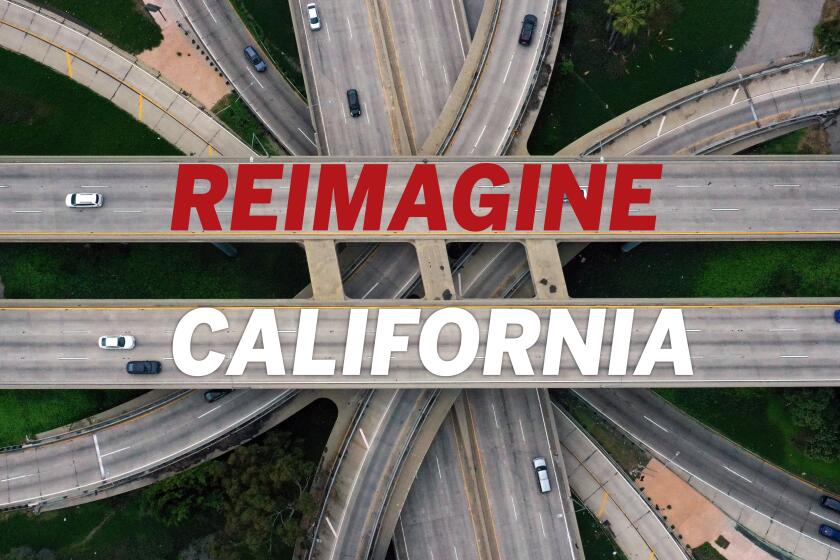Editorial: We don’t need a theater to know when movies are Oscar-worthy. The academy shouldn’t either
One of the most acclaimed movies of all time, David Lean’s “Lawrence of Arabia,” is a poem to the ever-changing desert sandscape, shot with panoramic cameras on unusually wide film. You weren’t meant as much to watch this 1962 film as to immerse yourself in it — in a theater.
Most everyone has had their breath taken away in a darkened cavern of a cinema. Maybe you watched Stanley Kubrick’s “The Shining” and could barely sleep that night. The shark of biblical proportions in Steven Spielberg’s “Jaws” spooked some moviegoers so much that they avoided the beach.
Or, watching Alfred Hitchcock’s “Vertigo” (spoiler alert!), perhaps you screamed at the bell tower scene when the duplicitous Kim Novak is so unnerved by the approach of a shadowy figure that she backs up in fright and plummets to her death. You wouldn’t be alone; Hitchcock could make an entire audience scream as one.
Yet even if Americans have profound memories of experiencing movies in a theater, today, for the most part, they see new movies on their TV screens, personal computers, tablets and phones. They have mentally disconnected the desire to see a movie from the need to see it in a movie theater.
The Academy of Motion Picture Arts and Sciences — bestower of the Oscars, the industry’s highest awards — has for years maintained that a movie is worthy of consideration only if it debuts in a theater. More specifically, a movie could not contend for an Oscar unless it played for a week in a theater in Los Angeles County, with no home video release before it started its theatrical run. That rule was sacrosanct — until the pandemic came along, shuttering movie theaters across the country, upending studios’ plans for opening weekends, pushing film debuts into late this year or next and sending some films straight to premium video and streaming services.
As a result, the Academy last month took the unprecedented step of waiving the requirement of a theatrical opening for a movie to get Oscar consideration while cinemas are closed (as long as the movie had been set for theatrical release). Academy officials made it clear that this was a temporary move, however, and that when theaters reopened, the requirement would be restored. “The Academy firmly believes there is no greater way to experience the magic of movies than to see them in a theater. Our commitment to that is unchanged and unwavering,” top Academy officials said in a statement.
We think the change should become permanent. The industry has been edging away from its dependence on the multiplexes for some time. More and more films are produced by Netflix, Amazon and other streaming companies; more viewers are watching movies on devices; and the theaters’ “window,” the period in which a movie is available only on their screens, not online or on DVD, has gotten shorter — so short in some cases that you barely need a calendar to measure it.
Such a change in Academy rules won’t cause movies to wither as an art form and become indistinguishable from productions made for television — or, at least, any more indistinguishable than some are now. Nor will theaters die — at least not as a result of a change in Oscars eligibility. In whatever form the multiplexes and independent theaters reopen, people will go there, in part because seeing a movie in a theater may indeed offer its most magical experience. People will see the latest “Fast and Furious” installment in a theater to feel and hear the rush of the action in all its magnified intensity. Christopher Nolan will still make ambitious, immersive movies like “Dunkirk” that are best seen and grasped on a 72-foot screen. And people will still go to a movie theater to be awed by them.
Help the Los Angeles Times reimagine what California should look like after the COVID-19 pandemic ends.
We don’t float this idea cavalierly. Movies — at their best — are among the greatest artistic expressions we have. The history of filmmaking in the U.S. is inextricably linked with the history of Los Angeles. It is an art form we want to thrive. It will always be a challenge to get a movie financed — they can be preposterously expensive to make — and distributed and seen, but considering the vagaries of the filmmaking business and the uncertainty surrounding how health and safety orders will affect theaters after they reopen, why not allow any gifted storyteller who makes a film that gets distributed straight to a streaming service to be considered for an honor he or she deserves? Shouldn’t an Oscar measure the work, not where it’s shown?
For more than half a century, movie theaters have successfully fought back intruders at the gate — television, cable channels, movie rentals, DVDs and now streaming services. Even though attendance has declined, the National Assn. of Theatre Owners’ statistics show box office revenue has gone up over the last decade and held steady over the past couple of years. Viewers still flock to theaters to see blockbuster action movies such as “Black Panther,” “The Avengers” and the latest iteration of “Mission: Impossible.”
Gone are the TV sets that would have chopped off the sides of a 70-millimeter movie like “Ben-Hur.” But even as flat TV screens have advanced to the point where they can show movies in their full widescreen format in incredible detail, a screen in your living room can’t offer sound and visuals as magnified as a movie theater can, or the communal experience of sharing an emotional ride with a packed house.
Granted, younger filmgoers have grown up watching movies on screens even smaller than the TVs their parents grew up with. Wheeler Winston Dixon, the author of “Synthetic Cinema: The 21st Century Movie Machine,” says his film students will go to a theater to watch a Marvel movie, “but I have students who’ll watch ‘2001’ on a cellphone.”
And when it comes to nominating and choosing Oscar winners, the reality is that many, if not most, members of the Academy watch movies on “screener” DVDs — or, increasingly, through a streaming platform — before making their choices. So even those at the top of their craft, the arbiters of cinematic quality, often aren’t seeing Oscar-worthy movies in a theater. Besides, the movies that draw the most Oscar attention — for example, Barry Jenkins’ “Moonlight” — are often not the blockbuster action movies that fill theater seats.
We understand that dispensing with the theatrical release requirement now could look like kicking theaters when they are down. That’s not the intent. Theaters are a vital part of the movie experience. However, the tensions between theater owners and studios will continue no matter what the requirements are for Oscar consideration.
When Universal Pictures executives decided they couldn’t wait for theaters to reopen to release the animated “Trolls World Tour,” they sent it off to video on demand on April 10, and it made nearly $100 million in three weeks. Universal’s Jeff Shell said later that once theaters reopened the studio would release some movies “on both formats,” causing theater owners to freak out. The chief executive of the AMC theater chain decreed that if Universal released movies simultaneously to digital platforms and multiplexes, AMC would no longer license any of the studio’s movies in any of its 1,000 theaters. But that’s a business spat, not an artistic one.
Still, critics suggest that dispensing with the theatrical release requirement would worsen a cascade of industry problems. Former studio executive and producer Bill Mechanic (who earned a best picture nomination as a producer of the 2016 movie “Hacksaw Ridge”) contends that smaller movies that play in theaters often draw attention from viewers and critics that distinguishes them from the pack and heads them toward Oscar consideration. Even a brief run in a movie theater can attract the attention that garners an Oscar nomination and boosts a film economically by keeping it in theaters longer or bringing it back for another run.
But the dynamics of the decision about which films go into a theater won’t change. Even if the Academy dropped its requirement, a distributor could still make the calculus that putting a movie into theaters — at the same time or before it went to a streaming service — was worth the cost because it would help get critical attention and Oscar consideration. Streaming services could continue to seek theatrical runs for movies they produce when it’s important to their filmmaking partners or when they want to make a wider splash in the industry.
Some people worry that movies without a theatrical release will get lost in the abyss that is, say, Netflix, a ravenous buyer and purveyor of massive amounts of content. That’s a realistic concern; as streaming services have grown into bigger players in the market, independent production and distribution companies have struggled to exist and finance the small movies that are their bread and butter.
But movies get lost at the cinemas too. Plenty of little film jewels play for a weekend or so and get kicked out of theaters when they don’t do well at the box office. It’s a brutal business, and the Academy’s insistence that films debut in movie theaters to qualify for awards hasn’t made it any kinder.
The thorniest issue may be this: If the Academy no longer requires a movie to debut in a theater, what makes it different from a movie made for TV? How would an Oscar be different from an Emmy? When you have a couple of generations of movie lovers watching films on their laptops and smartphones, that might be a distinction without a difference. But rather than sending Academy officials into convulsions of outrage, we can leave that debate for another day.
The real question is — and always has been — what distinguishes a great movie, a remarkable movie, from the rest of the pack? Compelling storytelling, great acting, gorgeous photography that serves the story — those are the sorts of qualities that make a movie worthy of an Oscar. Not a stint in a movie theater.
More to Read
A cure for the common opinion
Get thought-provoking perspectives with our weekly newsletter.
You may occasionally receive promotional content from the Los Angeles Times.











